Affiliate disclosure: This post may contain affiliate links. Please see our Privacy Policy.
Sea Buckthorn (Hippophae rhamnoides) has been getting quite a bit of press lately as the newest superfood, but it’s nothing new. Permaculture enthusiasts have been planting sea berries for years now because they’re a hardy nitrogen-fixing perennial with few pests and high yields of tasty berries. The fact that those tasty berries are also particularly healthy is just a nice bonus.
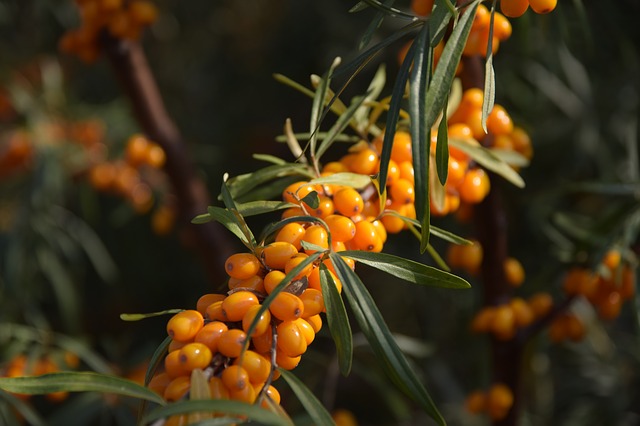
Also known as sea berry, sand thorn and sha-ji, sea buckthorn is hardy down to zone 3 (-35 F) native to both Europe and Asia. The plants are dioecious, which means that individual bushes are either male or female. Only the female bushes bear fruit, and it’s generally suggested to plant one male sea buckthorn bush for every 6 females to ensure good pollination.
The plants themselves are somewhere between a shrub and a small tree (20 ft tall) in growth form, and very spikey. The spines ensure they’re deer resistant, and they’re often planted densely to form an effective hedge barrier around properties.
Since they’re nitrogen-fixing, sea buckthorn can grow on marginal soils. It’s often planted to stabilize eroding banks, especially along roads since it’s a remarkably salt tolerant plant.
While sea buckthorn plants are remarkably tolerant of a variety of conditions, including poor soils and drought. That said, they prefer soil with good drainage and don’t thrive in boggy conditions.
They also require full sun to bear good crops of fruit. Trees may limp along in part shade, but they won’t bear in those conditions.
The flowers are small and hardly noticeable, but when the plants become covered in fruit in the fall it’s quite a show.
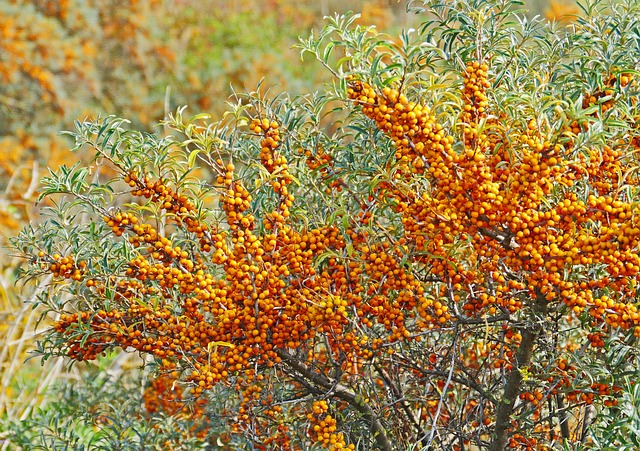
Propagating Sea Buckthorn from Cuttings
Since only female plants bear fruit, sea buckthorn is often propagated from cuttings to ensure the sex of the resulting plants. Some growers even go as far as propagating female plants from cuttings, and then grafting a single male branch onto each female bush for pollination. This ensures that there’s a male plant available nearby for pollination, but none of the planting space is taken up by an unproductive male plant.
To propagate sea berries from hardwood cuttings, take cuttings 6” from last year’s growth while the plant is dormant (late fall to early spring). Soak the cuttings in water covering about 2/3 of their length, changing the water every day to prevent stagnation.
After about a week, roots should begin to form. Once the roots are about an inch long the cuttings can be planted indoors in pots for about 2 months until the plants are fully rooted and ready to be transplanted outdoors.
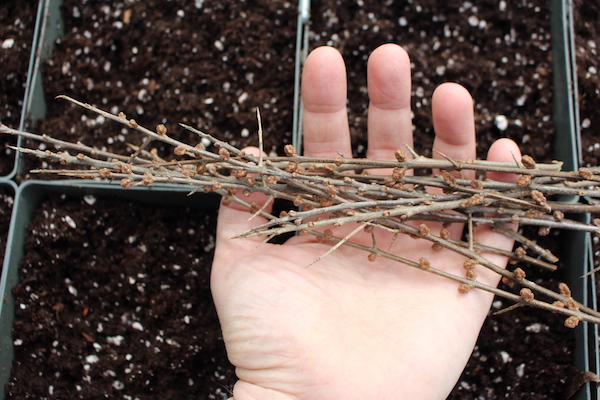
While many hardwood cuttings like grapes and elderberries benefit from the addition of rooting hormone, studies have shown that it’s completely unnecessary for propagating sea buckthorn cuttings. The study found that small-diameter cuttings from 1-year-old wood (2 to 4 mm in diameter) had a 97% rooting rate without any hormonal treatment.
I’ve also read that since buckthorn suckers readily, especially when cut to the ground, that propagating from root cuttings has a high success rate.
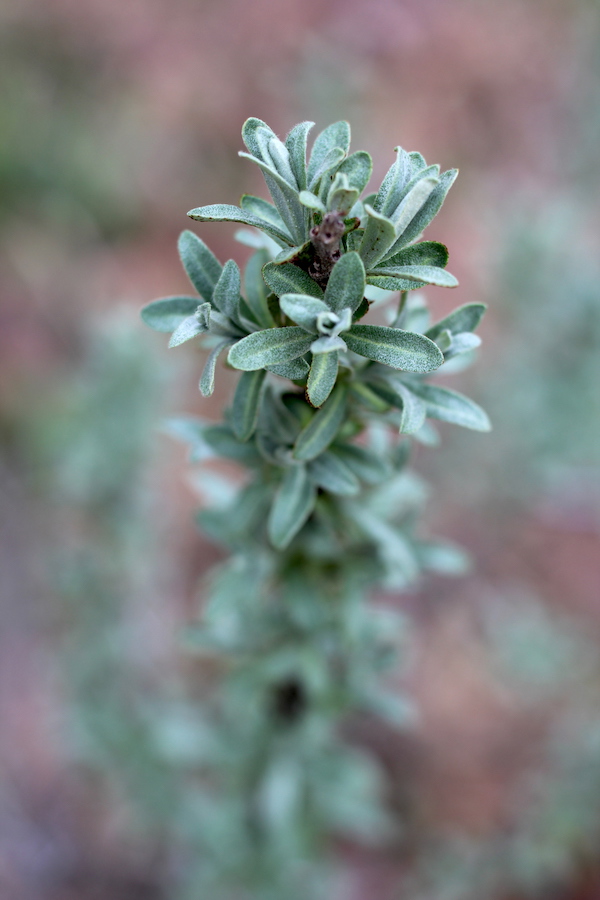
Growing Sea Buckthorn from Seed
We purchased 10g seed in bulk from Strictly Medicinals Seed, and they suggest a few different planting options.
Either scarify the seed on medium grit sandpaper, then sow in fall or very early spring outdoors. Or, scarify and give 30 to 90 days moist refrigeration and sow indoors in a warm environment. Transplant to successively larger pots until the plants are large enough to be transplanted outdoors.
The seeds are scarified by placing them on a sheet of sandpaper and then sandwiching another sheet of sandpaper on top. Rub the two pieces together to scrape up the outside of the seed coats. This mimics going through a bird’s digestive tract and helps encourage the seeds to sprout.
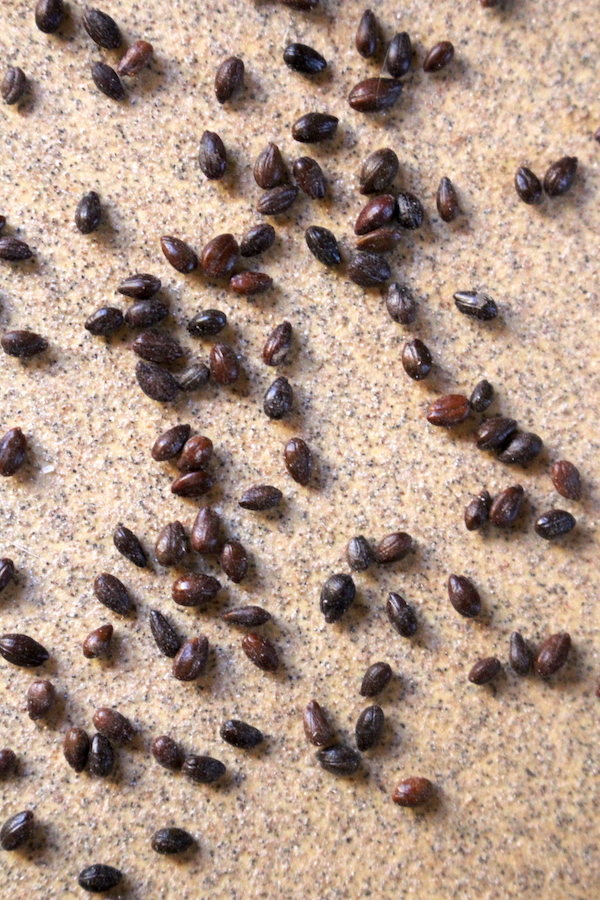
Other sources I’ve read recommend cold stratification for the full 90 days, followed by soaking in water for 2 days. When planted, the seeds germinate best at the soil surface exposed to light rather than buried.
For that reason, some people germinate them in Ziploc bags set in the sun with a bit of potting medium or a paper towel to hold moisture. Once the seeds germinate they’re then moved to pots.
Strictly Medicinal Seeds notes that it’s a “dependable and fun germinator” so we had high hopes for our 10-gram packet with an estimated 1,800 seeds inside. After scarification, I completed 90 days of cold moist stratification on moist paper towels in the refrigerator.
After that, I scraped the seeds off the paper towels and onto seedling trays. I completely forgot about the light exposure part and sprinkled 1/8 to 1/4 inch soil over them.
The seeds didn’t care, and though I never counted to determine actual germination rates, we must have 1000 sea buckthorn seedlings at this point…
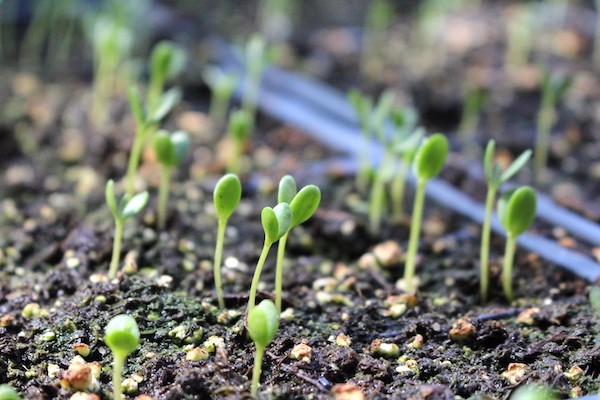
Uses of Sea Buckthorn
For the most part, my kids eat sea buckthorn right off the plant. I can’t say they particularly enjoy the berries, as they’re absurdly tart. They seem to get a kick out of how sour the berries are, especially since they’re planted near other much sweeter fruits like black raspberries and thimbleberries.
Nonetheless, they’ll pull those bright orange berries right off the plants again and again. Smiling with anticipation before each one goes in their mouths, and then puckering up afterward. Much laughter ensues, and then they do it again.
Humor in the eyes of preschoolers…
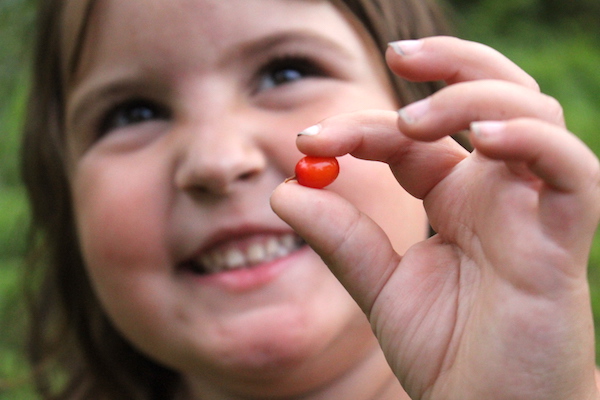
Needless to say, sea buckthorn is not popular for fresh eating.
Since it’s gained “superfood” status sea buckthorn can be found in all manner of products marketed by companies trying to capitalize on the hype. Anything from foods and juices to cosmetics and skincare products.
There are plenty of health claims related to sea buckthorn, but the most reputable seems to be related to skin health and mental function. The seeds contain an oil that’s marketed as “sea buckthorn oil” which is an effective treatment for all manner of skin disorders. That same oil is also purported to be an effective sunblock.
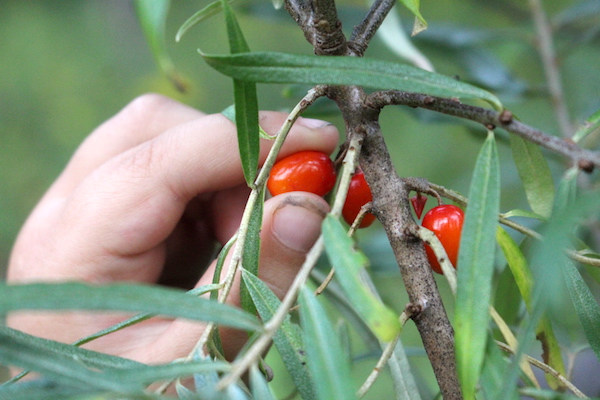
The fruit themselves are rich in omega 3 fatty acids, along with a long list of amino acids and antioxidants. They’re second only to rose hips in total vitamin C content too.
The fruit is quite tart, and it’s often either pressed into a juice that’s sweetened and drunk or made into a sweetened jam. That said, there are plenty of people that eat them out of hand. Here are a few sea buckthorn recipes to try with your first harvest:
- Sea Buckthorn Tea with Honey & Cinnamon
- Sea Buckthorn Chutney
- Sea Buckthorn Oxymel
- Sea Buckthorn Cheesecake
- Sea Buckthorn and Apple Jelly
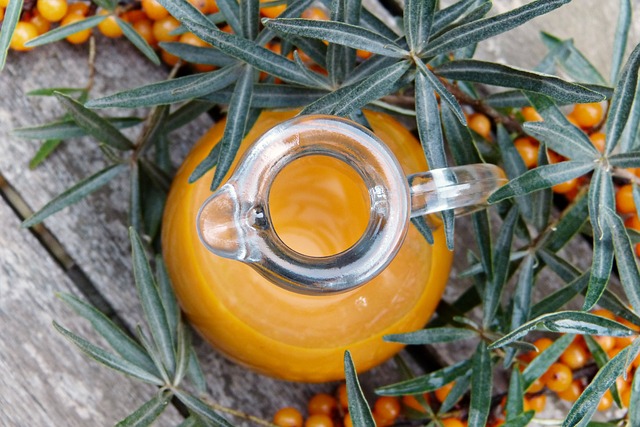
Sea Buckthorn Living Fence
At this point, we have a number of sexed sea buckthorn plants on our land to use for hardwood propagation. I also have a large envelope of seed ready to be cold stratified before this coming spring.
Our plan? A sea buckthorn hedge around our new roughly 1-acre permaculture garden. Right now our permaculture plantings are spread out across about 3-4 acres of land, nothing in high density.
Now that we’ve cleared a new zone we’re planning a dense permaculture food forest, hedged against deer by a dense fence of sea buckthorn.
Will it work? I’ll let you know in a few years…















i have 22 year old seabury bushes and never had a flower or fruit. they in full sunn , grow like crazy . 7years ago i bought 2 more 1 male 1female , thight maybe i got 2 of the same gender and thatht was the problem. Nope,the are all growin quite well but still nothing.i would sure like to know whats up as i would like to harvest these great berries
That’s a tricky one. Lack of fruit has never been a problem for us, and I’m honestly not sure what the cause might be.